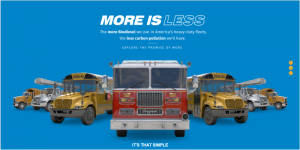The National Biodiesel Board (NBB) has launched a new advertising campaign, “More is Less“. The ad show that Americans can reduce carbon emissions and other pollution by using more biodiesel in vehicles and fleets. “Using more biodiesel means less fossil fuel, less carbon emissions, less carcinogens, less environmental impact,” said Donnell Rehagen, NBB’s Chief Operation Officer and Interim CEO. “Even if you don’t drive a diesel vehicle or operate heavy machinery, we are showing consumers that biodiesel is working for you, cleaning the air and improving the environment.”
 Biodiesel is the most commonly used alternative fuel option for fleets with data from the 2016 Fleet Purchasing Outlook study finding 18 percent of fleets use biodiesel today up from 15 percent in 2015. The study also found that more fleets are planning to acquire or continue to use biodiesel than any other alternative fuel option. NBB says demand has been fueled by biodiesel’s low carbon fuel status and its reduction of GHGs by as much as 80 percent or more when compared to petroleum diesel.
Biodiesel is the most commonly used alternative fuel option for fleets with data from the 2016 Fleet Purchasing Outlook study finding 18 percent of fleets use biodiesel today up from 15 percent in 2015. The study also found that more fleets are planning to acquire or continue to use biodiesel than any other alternative fuel option. NBB says demand has been fueled by biodiesel’s low carbon fuel status and its reduction of GHGs by as much as 80 percent or more when compared to petroleum diesel.
Produced by PCI Communications, the 30-second television commercial features Medford Township (New Jersey) Public School buses weaving their way through town while a narrator explains the district’s history with biodiesel. In May, the EPA presented Medford with the 2016 Environmental Champion Award at a ceremony in New York City. The award honors Medford’s outstanding commitment to protecting and enhancing environmental quality and public health. Medford’s leadership in the use of biodiesel alone has eliminated 123,376 pounds of smog-forming emissions, 2,408 pounds of diesel particulate matter and reduced its fleet operation costs by over $170,000.
The 2016 NBB campaign also includes a refreshed website. Additional vignettes include:
- City of New York: In 2013, New York City planned for their 9,000 diesel-powered municipal fleet vehicles to biodiesel blends. It began with the Parks Department, which found compliance so easy it soon upped its biodiesel use to B-20 in its vehicles. Other departments followed suit, including the Department of Sanitation, which began using biodiesel in all of its fleet vehicles. With Sanitation consuming 80% of New York City’s fleet fuel, its move to biodiesel has paid dividends. The city has experienced a 19% reduction in carbon emissions since 2005, on track to reaching an 80 percent reduction by 2050.
- Salt River Project, electricity provider to the Phoenix Metropolitan Area: Biodiesel provides power for more than 900 of the company’s vehicles. Since its biodiesel pilot program began in 1999, SRP has converted 41% of its fleet to B-20. Of its nearly 2,300 vehicles, 950 run on biodiesel. By using more B20 in its fleet, SRP has saved money and upheld its environmental stewardship.
In addition to the stories of biodiesel use from local enthusiasts, visitors to the website are invited to learn more about biodiesel and even take a fun quiz to “Test Your Bio-Q.”

